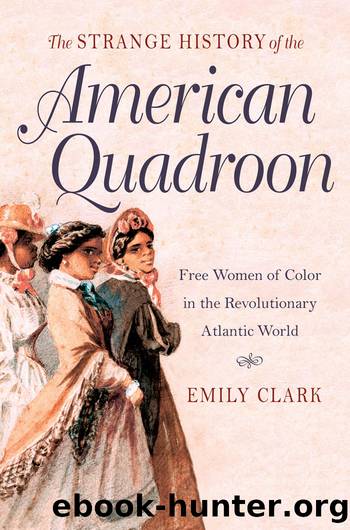The Strange History of the American Quadroon by Emily Clark

Author:Emily Clark [Clark, Emily]
Language: eng
Format: epub
Tags: History, United States, State & Local, South (AL; AR; FL; GA; KY; LA; MS; NC; SC; TN; VA; WV), Social Science, Women's Studies
ISBN: 9781469607528
Google: Gc7gn5SHL98C
Publisher: UNC Press Books
Published: 2013-01-15T04:01:38+00:00
Ingraham followed his quadroon short story with a full-length novel in 1841, The Quadroone; or, St. Michaelâs Day. Set in the late 1760s, when the Spanish took control of New Orleans from the French, the work is saturated in orientalism. The villain of the piece, the Spanish Count Osma, comes to New Orleans to take possession of the city for Spain. One of the cavaliers he sends as his advance guard, Don Henrique, is wounded and brought unconscious to the home that the beautiful quadroon woman Azèlie shares with her quadroon brother, Renault. As Henrique awakens, âHis glance at the instant rested on a hand and arm like moulded pearl, laid upon the head of the ottoman. His heart leaped to his mouthâ as he gazed at the figure before him. âHalf in the moonlight, half in the shade, supported by her arm, with her face hidden in the abundance of her jetty hair that fell over it, reposed the most graceful form his imagination could pencil.â Henrique, thinking he must have died from his wounds, exclaims, âSurely this is Paradise; and this is an Houri!â11 Henrique, the Catholic Castilian, awakes not to an angel welcoming him to a Christian heaven, but to a houri, âa nymph of the Muslim Paradise,â a being of incomparable beauty and sensuality that some believed welcomed virtuous Muslim men to the afterlife.12
Azèlie is dressed for the part of a Muslim beauty, in attire that would be very much at home in a famous North African scene conjured by the French orientalist Eugene Delacroix in 1834 and recapitulated in similar images created on both sides of the Atlantic (see Figures 9 and 10).13 Dressed in a vest âof the finest lawn, with large and loose sleeves, open at the neck and breast, embroidered with gold, and ornamented with little diamond buttons,â Azèlieâs costume mimics exotic sartorial habits, with âdrawers of the finest linen, deeply bordered with lace, and around her waist . . . a broad sash of silk and gold folded together, the ends of which, entwined with precious stones, hung long from behind.â To complete her incarnation as an oriental enchantress, Azèlie replicates the signature conventions of the seraglio right down to her toes. âHer slipper of golden tissue, curiously embroidered, had fallen off too, and a naked little foot, all warmth and beauty, and like a childâs in its minute and soft proportions, caught the moonlight and finished the picture.â14
Not only is Azèlie taken for a houri and dressed appropriately for a North African harem, but the dramatic conclusion of the novel reveals that she is not a quadroon at all, but a Moroccan princess. In his youth, Count Osma was held captive by the âEmperor of Moroccoâ for several years. While there, the emperorâs daughter, Zillah, fell in love with him, and they were married in a Muslim ceremony. Osma, however, abandoned his Moroccan wife and returned to Spain, where he took a Christian wife. Zillah followed him to Spain and
Download
This site does not store any files on its server. We only index and link to content provided by other sites. Please contact the content providers to delete copyright contents if any and email us, we'll remove relevant links or contents immediately.
| Americas | African Americans |
| Civil War | Colonial Period |
| Immigrants | Revolution & Founding |
| State & Local |
In Cold Blood by Truman Capote(3311)
The Innovators: How a Group of Hackers, Geniuses, and Geeks Created the Digital Revolution by Walter Isaacson(2849)
Steve Jobs by Walter Isaacson(2837)
All the President's Men by Carl Bernstein & Bob Woodward(2331)
Lonely Planet New York City by Lonely Planet(2173)
And the Band Played On by Randy Shilts(2131)
The Room Where It Happened by John Bolton;(2105)
The Poisoner's Handbook by Deborah Blum(2094)
The Murder of Marilyn Monroe by Jay Margolis(2059)
The Innovators by Walter Isaacson(2057)
Lincoln by David Herbert Donald(1949)
A Colony in a Nation by Chris Hayes(1881)
Under the Banner of Heaven: A Story of Violent Faith by Jon Krakauer(1750)
Amelia Earhart by Doris L. Rich(1650)
The Unsettlers by Mark Sundeen(1647)
Being George Washington by Beck Glenn(1628)
Birdmen by Lawrence Goldstone(1621)
Dirt by Bill Buford(1613)
Zeitoun by Dave Eggers(1594)
